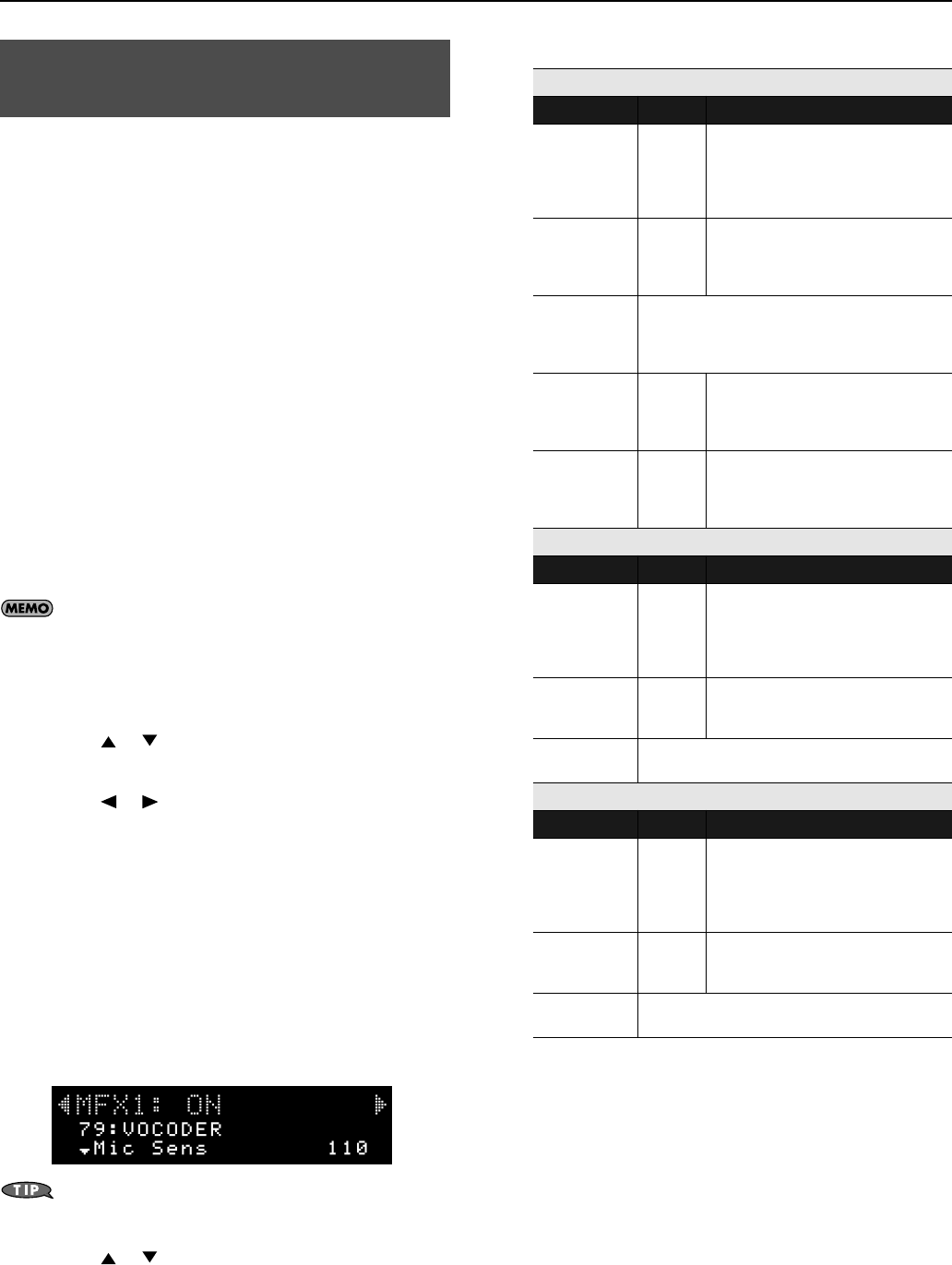
61
Detailed Tone Settings
The process of modifying the effect settings is called “effect editing.”
You can make effect settings independently for when playing a tone by
itself and for when using Split, Dual, or Super Layer (when the [PERFORM]
button is lit).
When playing a single tone
You can use multi-effect (MFX), chorus, and reverb for each tone.
When playing more than one tone
For each setting, you can use a maximum of three multi-effects (MFX1,
MFX2, MFX3), one chorus, and one reverb. For Split or Dual, you can use
two multi-effects (MFX1, MFX2).
The details are as follows.
For Super Layer
MFX1 applied to all parts.
For Split
MFX1 applied to upper, MFX2 applied to lower.
For Dual
MFX1 applied to part 1, MFX2 applied to part 2.
Otherwise
You can use the included “JUNO-Di Editor” to edit MFX1–3.
Use the included “JUNO-Di Editor” if you want to make detailed
settings for the MFX used by each part.
1.
Press the [MENU] button.
The “MENU” screen will appear.
2.
Use the [
] [ ] buttons to select “EDIT,” and press
the [ENTER] button.
3.
Use the [
] [ ] buttons to make the desired effect
appear in the upper line of the screen.
The available effects will depend on the current selection.
When only one tone is selected
“MFX,” “CHORUS,” “REVERB”
When using Super Layer
“MFX1,” “CHORUS,” “REVERB”
When using Split or Dual
“MFX1,” “MFX2,” “CHORUS,” “REVERB”
Otherwise
“MFX1,” “MFX2,” “MFX2,” “CHORUS,” “REVERB”
fig.disp-mfxedit.eps_70
You can access the edit screen of step 3 by holding down the
[SHIFT] button and pressing the [PIANO] button.
4.
Use the [
] [ ] buttons to move the cursor to the
item that you want to edit.
5.
Use the dial to set the desired value.
6.
Press the [EXIT] button to leave the edit screen.
Editing the Effects (MFX/Chorus/
Reverb) (Effect Edit)
MFX1–3
Item Value Description
MFX 1–3
switch
OFF, ON
Specifies whether MFX 1–3 will be used
(ON) or not used (OFF).
* This setting is common to the entire
JUNO-Di.
* This setting cannot be saved.
00: THRU–79:
VOCODER
(MFX Type)
00–79
Selects the types of multi-effects that
MFX1–3 will use.
Choose “00: THRU” if you don’t want to
apply a multi-effect.
Items for each
MFX type
The editable items for the selected MFX type will be
displayed.
Refer to “Multi-Effects Parameters (MFX1–3, MFX)” (p.
93).
Cho Send
Level
0–127
Adjusts the amount of chorus for the
sound that passes through multi-effects.
If you don’t want to add the chorus effect,
set it to “0.”
Rev Send
Level
0–127
Adjusts the amount of reverb for the
sound that passes through multi-effects.
If you don’t want to add the reverb effect,
set it to “0.”
CHORUS
Item Value Description
Chorus switch
OFF, ON
Specifies whether chorus will be used
(ON) or not used (OFF).
* This setting is common to the entire
JUNO-Di.
* This setting cannot be saved.
00: OFF–03:
GM2 CHORUS
(Chorus Type)
00–03
Selects the types of chorus.
Choose “00: OFF” if you don’t want to
apply a chorus.
Items for each
chorus type
Edit the parameters for the selected chorus type.
Refer to “Chorus Parameters” (p. 104).
REVERB
Item Value Description
Reverb switch
OFF, ON
Specifies whether reverb will be used (ON)
or not used (OFF).
* This setting is common to the entire
JUNO-Di.
* This setting cannot be saved.
00: OFF–05:
GM2 REVERB
(Reverb Type)
00–05
Selects the types of reverb.
Choose “00: OFF” if you don’t want to
apply a reverb.
Items for each
reverb type
Edit the parameters for the selected reverb type.
Refer to “Reverb Parameters” (p. 104).
JUNO-Di_e.book 61 ページ 2009年6月22日 月曜日 午前9時23分


















